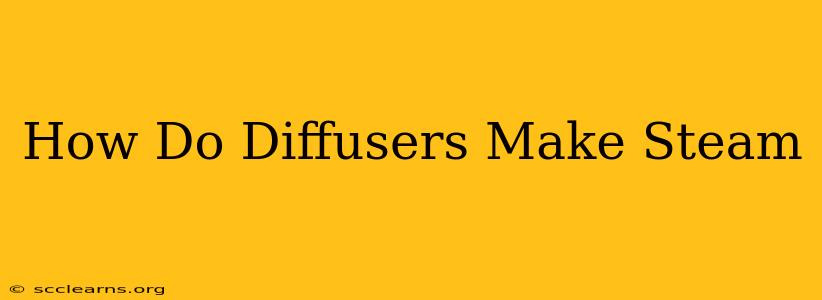Aromatherapy diffusers are a popular way to enjoy the benefits of essential oils, filling your space with pleasant scents and potential therapeutic effects. But have you ever wondered how these devices actually work? Understanding the science behind how diffusers make steam is key to appreciating their functionality and choosing the right one for your needs.
The Science of Steam Diffusion: A Breakdown
Most steam diffusers operate on a simple principle: boiling water to create steam. This steam then carries the essential oil molecules into the air, allowing you to experience their aroma. However, different types of diffusers employ slightly different methods to achieve this.
Ultrasonic Diffusers: High-Frequency Vibrations
Ultrasonic diffusers are the most common type. They use a small metal plate that vibrates at a high frequency (typically 2.4 million times per second!). These vibrations create a fine mist of water and essential oil, which is then released into the air as a cool vapor. This process is gentle and doesn't heat the oils, preserving their therapeutic properties. No boiling is directly involved, making them very safe.
Key features of ultrasonic diffusers:
- Quiet operation: Ideal for bedrooms or other quiet spaces.
- Cool mist: Preserves the integrity of essential oils.
- Easy to clean: Generally simple to maintain.
Nebulizing Diffusers: Pure Essential Oil Vapor
Nebulizing diffusers take a different approach. Instead of using water, they directly atomize the essential oil into a fine mist using compressed air. This means you're inhaling pure essential oil vapor, resulting in a stronger and more potent aroma. Because there's no water involved, they are also very efficient.
Key features of nebulizing diffusers:
- Stronger scent throw: Ideal for larger rooms.
- No water needed: Simple and easy to use.
- Potential for oil residue: Requires careful cleaning to prevent clogging.
Heat Diffusers: Gentle Evaporation Through Heat
Heat diffusers utilize a heating element to gently warm the water and essential oils, causing the water to evaporate and releasing the aromatic compounds into the air. These are similar to simmering pots you might find in some aromatherapy practices. While effective, they can be less energy-efficient than other types.
Key features of heat diffusers:
- Gentle heating: Prevents degradation of essential oils (though less so than ultrasonic).
- Suitable for smaller spaces: Effective scent dispersion in smaller areas.
- Higher energy consumption: Compared to ultrasonic and nebulizing diffusers.
Choosing the Right Diffuser for You
The best type of diffuser for you depends on your needs and preferences. Consider the following factors:
- Room size: Nebulizing diffusers are best for larger rooms, while ultrasonic diffusers are suitable for smaller spaces.
- Scent intensity: Nebulizing diffusers provide a more potent scent, while ultrasonic diffusers offer a gentler aroma.
- Safety: Ultrasonic diffusers are generally safer for use around children and pets due to the lack of heating elements.
- Maintenance: Consider the cleaning requirements of each type before making a purchase.
Understanding how these different types of diffusers work helps you make an informed decision when choosing the perfect device to enhance your aromatherapy experience. By selecting the right diffuser, you can effectively and safely enjoy the benefits of essential oils.

